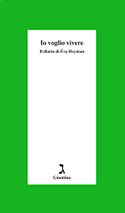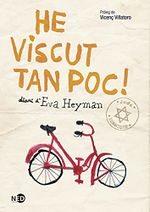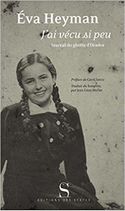Éva Heyman (F / Hungary, 1931-1944), Holocaust victim
Éva Heyman (F / Hungary, 1931-1944), Holocaust victim.
- KEYWORDS : <Hungary> <Auschwitz>
- MEMOIRS : The Diary of Éva Heyman (1948; ET 1974)
Biography
Eva Heyman (Hungarian: Heyman Éva, 13 February 1931 – 17 October 1944) was a Jewish girl from Oradea. She began keeping a diary in 1944 during the German occupation of Hungary. Published under the name The Diary of Eva Heyman, her diary has been compared to The Diary of Anne Frank. She discusses the extreme deterioration of the circumstances the Jewish community faced in the city, offering a detailed account of the increasingly restrictive anti-Jewish laws, the psychological anguish and despair, the loss of their rights and liberties and the confiscation of property they endured. Heyman was 13 years old when she and her grandparents were murdered in the Holocaust.
Heyman started writing her diary on her thirteenth birthday 13 February 1944 (the same year Germany occupied Hungary). The town she was born has been called Nagyvárad by Hungarians and Oradea by Romanians. When she was born it was part of Romania; in her diary, Heyman calls it "Varad", short for Nagyvárad, a colloquial name widely used. The city was part of Hungary that time.
She was raised in an assimilated Hungarian-Jewish family. Her father, Béla Heyman, was an architect from a prominent family. The family owned a hotel which Heyman wrote was "full of Persian rugs". Her parents divorced when she was a young child. Her mother married socialist writer Béla Zsolt. Her grandfather was a pharmacist, who had supported the Kingdom of Hungary against Romania. Heyman recalls watching the arrival of Miklós Horthy from the window of her grandfather's pharmacy.
Her mother Ágnes "Ági" Zsolt was also a pharmacist. Her daughter described her as "more beautiful than Greta Garbo". Ági and Zsolt were living in Paris when the Germans invaded Poland. Terrified for her daughter, she convinced her husband to return to Budapest. She was held at the Bergen-Belsen concentration camp, but made it to safety in Switzerland after she was rescued from the camp. Her mother committed suicide after her daughter's diary was published. The location of the original manuscript is not known.
Being raised in a political family, Heyman and her grandparents would have been expecting rough treatment as the Nazis approached Nagyvárad in 1944. Heyman was morbidly preoccupied with her own death at the hands of the Nazis, which she grew to believe was inevitable after her best friend was killed by Nazis. Her diary begins as air raids sirens herald the approach of the Nazis in Nagyvárad. Together with her grandparents, Heyman was murdered in Auschwitz in October 1944.
Heyman's diary was published first in Hungarian. It was first translated into Hebrew by Yad Vashem in 1964, then into English by Moshe M. Kohn. The English edition was published by Yad Vashem in 1974.The diary has been compared to The Diary of Anne Frank.
In her diary she talks about her 13th birthday party, the last before she is murdered at Auschwitz. She writes of a pleasant party with tea, sandwiches, and a type of chocolate cake called Sachertorte. She is given a navy blue knit dress, a light tan spring coat and for the first time two pairs of sheer stockings. She also received an assortment of books, candies, records, oranges and chocolates.
She writes of her mother burning books written by Béla Zsolt, who she calls "Uncle Bela", and the destruction of works by other authors who were deemed dangerous like Ferenc Molnár. She admits to having read Molnár's novel The Paul Street Boys.
In 2012, a research center for Jewish history was opened at the University of Oradea (Nagyvárad) that was named after Eva Heyman.In 2015, in the city of Oradea (Nagyvarad) there was placed a statue of Eva Heyman in memory of the children of the city who were murdered in the Holocaust. It is situated in Bălcescu Park, from where over 20,000 Jews were deported by trains to Auschwitz between 24 May and 3 June 1944. This statue was the result of 3 years of hard pro bono work by the not for profit organisation and the generosity of donors from around the world. The sculptor was Flor Kent. In 2018 the statue was gifted by Asociatia Tikvah to the City of Oradea.In 2017, a theater show entitled "Eva Heyman: Anne Frank of Transylvania" was staged in Romania based on Eva's story.
In May 2019, a series of short videos that illustrate her story was uploaded to Instagram in the style that characterizes the media, under the title Eva Stories. The videos went viral and attracted worldwide interest. During the 2020 World Holocaust Forum in Jerusalem, world leaders planned to post Eva-related online messages in order to popularize the project and help combat anti-Semitism. On International Holocaust Day, 27 January 2020, Eva Stories was also launched on Snapchat.
BOOK : The Diary of Éva Heyman (1948; ET 1974)
- Originally published in Hungarian (Budapest: Uj Idok Irodalmi Intézet R.T. [Singer és Wolfner], 1948). English ed. (Jerusalem: Yad Vashem, 1974). Also published in Hebrew, Catalan, French and Italian.
Written by Holocaust victim Éva Heyman in 1944 (age 13), while living in Hungary under Nazi rule.
"The diary of Éva Heyman, born in 1931 in Nagyvárad, northern Transylvania (now Oradea, Romania), presented by her mother, Ágnes Zsolt. Her diary covers the period from 13 February (her 13th birthday) to 30 May 1944. At the time of the German occupation in March 1944, Éva was a student at the Jewish school. Her great-grandfather and a great-uncle had been Chief Rabbis of the Neolog Jewish community in the town in the 19th-20th centuries. Éva's parents had divorced, and her mother married the Hungarian Jewish writer Béla Zsolt, who lived in Budapest; Éva remained in Nagyvárad and was raised by her maternal grandparents, the Rácz family. In her diary, she gives a graphic description of the harsh events of the time, both in her home environment and in the city at large. When the ghetto was established in Nagyvárad, Éva's parents, who had been visiting in Nagyvárad, were also interned. They managed to escape from the ghetto to Budapest, where they were rescued on the Kasztner train. Éva, her grandparents, her biological father (Béla Heyman), his mother, as well as other family members were all deported to Auschwitz. Éva arrived in Auschwitz on 6 June, and was gassed on 17 October. Her mother presents here a very brief but heartrending description of Éva's experiences in Auschwitz. At the end, it was Mengele himself who sought her out and put her on the truck to be taken to the gas chamber. Her diary survived because she gave it to the family's cook who came to visit them in the ghetto on 30 May."--Publisher description.
Book : We Are Witnesses (1995), by Jacob Boas
- Jacob Boas, We Are Witnesses: Five Diaries of Teenagers Who Died in the Holocaust (New York, NY: Henry Holt, 1995).
"The five diarists in this book did not survive the war. But their words did. Each diary reveals one voice, one teenager coping with the impossible. We see Dawid Rubinowicz struggling against fear and terror. Yitskhok Rudashevski shows us how Jews clung to culture, to learning, and to hope, until there was no hope at all. Moshe Flinker is the voice of religion, constantly seeking answers from God for relentless tragedy. Éva Heyman demonstrates the unquenchable hunger for life that sustained her until the very last moment. And finally, Anne Frank reveals the largest truth they all left for us: Hitler could kill millions, but he could not destroy the human spirit. These stark accounts of how five young people faced the worst of human evil are a testament, and an inspiration, to the best of the human soul."--Publisher description.





